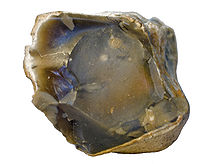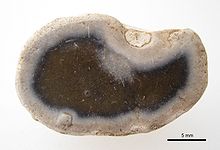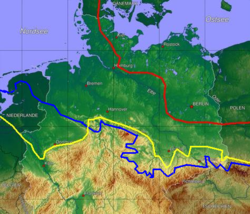Flint
![]()
The title of this article is ambiguous. For other meanings, see Flint (disambiguation).
Flint is a siliceous rock and consists almost exclusively of silicon dioxide (SiO2). The silicon dioxide is present in the form of very fine-grained (microcrystalline) quartz (chalcedony) and mogánite and/or in the form of opal. In addition, there are accessory minerals, for example hematite, which can give the rock a certain colour. Preferably, such formations are assigned the term flint, which are diagenetically formed in fine-grained marine limestones. The name flint refers to its historical importance in fire making. However, the "flints" used in modern lighters are made of a metal alloy (cerium-iron, see Auermetall) are called flintstones and are chipped. In addition, piezo crystals are struck in lighters to generate electric sparks.
In archaeology, the terms "flint", "chert" or "chert" are often used differently than in geology and mineralogy. In the German-speaking world, for example, "flint" is used as a generic term for flint minerals when they were used in prehistory and early history. It is one of the most important groups for the so-called rock implements.
Flint minerals, i.e. silicified mineral aggregates, are named differently according to the geochronological periods. Flint" from the Cretaceous and the lowest Tertiary (Danian) is called "flint". Typical sites include the Baltic coast (Baltic flint), the chalk cliffs of Rügen, the Maastrichtian region, the Burgundian region, etc. Flint-like materials from other, earlier epochs are called cherts, they are assigned to the Permian, Muschelkalk, Keuper and Jurassic in terms of formation history.

cracked flint nodule

broken open, hollow flint nodule from the Malm, Klettgau
Origin and properties
The origin of flint is still not fully understood. Presumably, silicic acid-containing solutions provide for a displacement of carbonates during the diagenesis (reaction and transformation processes during rock formation). Relics of skeletons of siliceous sponges and diatoms in flint nodules prove the organic origin. Flint consists primarily of fibrous chalcedony, similar to jasper (a cryptocrystalline but granular quartz, with grain size less than 1 micron). Flint diagenesis generally proceeds via opal-A (amorphous), opal-CT (easily worked like chalk) to flint.
The dehydration of the silica takes place from the inside to the outside, whereby the flint nodules often have an onion-like structure. The porous light outer layer (the so-called rind or cortex) is often clearly visible. This is the diagenetic precursor to flint, (SiO2 - nH2O), called opal CT. This is easily worked. The transformation of opal-CT to flint requires millions of years. The outer layers can absorb water to a small extent, which favours weathering of the surface.
Flint has an isotropic or amorphous structure, which means that it lacks a preferred orientation. When great pressure is applied slowly increasing or abruptly to a point of the flint, the kinetic energy is absorbed by the rock and spreads out concentrically in a cone shape starting from the point of impact. If the impact energy is sufficiently high, the rock is split by the propagating impact waves. The resulting fracture front usually has a conchoidal shape, as can also be observed in broken glass.
In the area of a fracture, the flint also exhibits impact waves, the Wallner lines. They occur mainly with deliberately split off parts of the stone, which are called knock-offs.
Fresh flint usually has a black to grey colour. It becomes increasingly milky through weathering; yellowish to brownish discolorations due to iron oxide can also occur. Red flint is rather rare; it is found in Central Europe, for example, on the beaches of the dune of Helgoland. The red colouring is the result of inclusions of trivalent iron compounds (for example hematite). The red flint originates from submarine chalk rocks of the Turonian (Upper Cretaceous) in the vicinity of the island. On Helgoland the red Helgoland flint is processed as a gemstone, set and sold as a polished disc, cut as a ring stone (cabochon) or spherically strung as a necklace.

Banded flint from North German boulder. The bands go back to a rhythmic silicification during the formation of the flint.

sawn open, small flint nodule with clearly pronounced lighter bark

Schematic representation of the respective maximum glacial advances (bedload) of the last three ice ages in the North German Lowlands: red line = ice margin of the Weichselian cold period; yellow line = ice margin of the Saale ice age; blue line = ice margin of the Elster cold period
Distribution in Europe
Flint deposits are found in numerous Jurassic and Cretaceous deposits. Mostly the nodules with a size of up to 30 cm diameter are embedded in chalk deposits. There are also slabs with thicknesses of up to 20 cm. Due to later rearrangement processes they can also be found detached from their original stratigraphic context of origin. Thus, flints are very common in glacial sediments as part of ground and terminal moraines as well as within meltwater deposits.
Distribution in Germany
In Germany, flint occurs in the parent rock, especially in the Cretaceous of Helgoland Düne, Rügen, Lägerdorf (Schleswig-Holstein) and Hemmoor (Lower Saxony). Secondarily redeposited it is found in the entire north-central European distribution area, there locally also extremely enriched (flint fields in the nature reserve Steinfelder in der Schmalen Heide and extension). In the mountainous region of southern Lower Saxony, flint is found as glacial till on the edge of the Harz Mountains and in the Leine Valley as far as Freden, north of the so-called flint line. It also occurs in white weathered form in Tertiary sands of the Miocene of the Solling and is known as chert from the Middle Muschelkalk (Göttingen to Einbeck), coral oolite/Heersum strata (Thüster Berg) and Hilssandstein.
The origin of this secondary rearrangement was the Elster Ice Age, whose ice masses penetrated as far as the northern edge of the Fahner Heights and carried large quantities of rock material from northern Europe with them. When the glacial ice melted, the erratic blocks and flints were left behind in the boulder clay. Erosion as well as the subsequent ice ages, Saale and Vistula ice ages, obliterated the original deposits, the flint line.
Flint also occurs in other areas of Germany, but more rarely, but was also found and used there. Flint blocks weighing tons, which were probably formed in the Knollenmergel, are found at Flinsberg near Oberrot, Baden-Württemberg.
· 
In the chalk cliffs on the island of Møn, layers of flint nodules can be seen as black bands.
· 
flints eroded from chalk cliffs on the island of Rügen
· 
Flint fields in the narrow heath on the island of Rügen
Questions and Answers
Q: What is flintstone?
A: Flintstone is a kind of sedimentary rock made of silica.
Q: Where is flint found?
A: Bands of flint are found embedded in chalk and other kinds of soft limestone.
Q: What happens to flint nodules when chalk is eroded?
A: When chalk is eroded, hard flint nodules survive as pebbles on a shingle beach.
Q: Can flint nodules be found in other rocks?
A: Yes, flint nodules can be cemented into another rock, such as a puddingstone, and make up a sedimentary rock for the second time.
Q: Is flint a hard or soft rock?
A: Flint is a hard rock, compared to chalk and soft limestone.
Q: What is the origin of flint?
A: Flint is made of silica, which is a mineral found in sedimentary rocks.
Q: How is flint formed?
A: Flint is formed over time by the accumulation of silica-rich material in the sedimentary rocks, and the subsequent cementation and hardening of this material into flint nodules.
Search within the encyclopedia